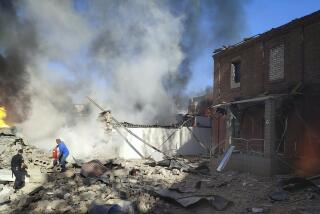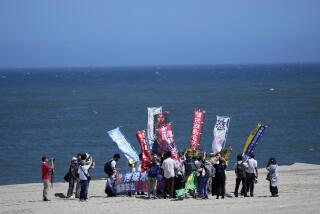Other Chernobyls Waiting to Happen? : The fear is of an archipelago of nuclear volcanoes
- Share via
The release of radioactive iodine that occurred Tuesday at the Leningrad Nuclear Power Station’s No. 3 unit near St. Petersburg, Russia, was no Chernobyl. But this accident--at a Chernobyl-style, graphite-moderated reactor--is nonetheless a grim reminder that aging Soviet-built reactors in the Commonwealth of Independent States and the post-Soviet Eastern European republics are Chernobyls waiting to happen.
What is the probability of another meltdown like that still-unfolding 1986 catastrophe? As the International Atomic Energy Agency met last month in Vienna, the environmental group Greenpeace claimed a 1-in-4 chance over the next five years. The IAEA itself has identified 10 Eastern European pressurized-water reactors as being at extreme risk. Using IAEA numbers, Greenpeace calculates the meltdown risk as greater than 27% over a five-year period.
In some quarters, to be sure, the name Greenpeace may be synonymous with environmental extremism; but more moderate voices have been raised lately in almost equal alarm. Paul Goble, a former State Department official who recently joined the Carnegie Endowment for International Peace, has faulted the Bush Administration for emphasizing Soviet weapons dismantlement to the neglect of the much greater short-term dangers posed by deteriorating nuclear reactors. Maurice Strong, secretary general of the U.N. environmental conference to be held in Brazil in June, has declared the Eastern European nuclear power plants an international environmental emergency and called for a large-scale rescue effort to prevent “a catastrophe that could do irreparable human, economic and environmental damage.” William Potter, director of Russian studies at the Monterey Institute of International Studies, told a Washington seminar last Friday that another Chernobyl was not only possible but likely.
The IAEA is in key regards, unfortunately, a toothless watchdog. Such inspections as it makes are made only with the consent of the host country. Its findings, as a report by the General Accounting Office recently revealed, are also made public only with the consent of the host country. (The U.S. Nuclear Regulatory Commission has access to IAEA information on foreign incidents but, in a policy recently denounced by Sen. John Glenn, chooses not to report it.)
For all its weakness, however, the IAEA remains the first line of international defense against the creation of an archipelago of nuclear volcanoes in Eastern Europe. And it is distressing, therefore, to learn that the IAEA’s 1992 budget of $187 million is down 13% from its 1991 budget, and that 20% of the funding for the 1991 budget was never received.
In the nations most directly affected, the safety-energy dilemmas are undeniably acute: A “scram” (emergency shutdown) order at Bulgaria’s dilapidated Kozloduy reactor would produce instant blackout in the capital city, Sofia. Thus the risk that--without outside help--nuclear safety will continue to be pushed into second place in Eastern Europe is correspondingly acute. But if the rescue that Maurice Strong has called for never materializes and more Chernobyls result, the cost in lives and dollars will be incalculable not just for all of Europe but for everyone on this fragile planet.
More to Read
Sign up for Essential California
The most important California stories and recommendations in your inbox every morning.
You may occasionally receive promotional content from the Los Angeles Times.










